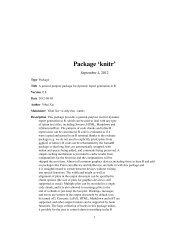Package 'openair'
Package 'openair'
Package 'openair'
You also want an ePaper? Increase the reach of your titles
YUMPU automatically turns print PDFs into web optimized ePapers that Google loves.
polarAnnulus 83limitscolswidth(which would result in a plot with too many gaps in it for sensible smoothing),or type = "weekday" and period = "weekday".Limits for colour scale.Colours to be used for plotting. Options include “default”, “increment”, “heat”,“jet” and user defined. For user defined the user can supply a list of colournames recognised by R (type colours() to see the full list). An example wouldbe cols = c("yellow", "green", "blue")The width of the annulus; can be “normal” (the default), “thin” or “fat”.min.bin The minimum number of points allowed in a wind speed/wind direction bin.The default is 1. A value of two requires at least 2 valid records in each bin anso on; bins with less than 2 valid records are set to NA. Care should be takenwhen using a value > 1 because of the risk of removing real data points. It isrecommended to consider your data with care. Also, the polarFreq functioncan be of use in such circumstances.exclude.missingSetting this option to TRUE (the default) removes points from the plot that aretoo far from the original data. The smoothing routines will produce predictionsat points where no data exist i.e. they predict. By removing the points too farfrom the original data produces a plot where it is clear where the original datalie. If set to FALSE missing data will be interpolated.date.padFor type = "trend" (default), date.pad = TRUE will pad-out missing data tothe beginning of the first year and the end of the last year. The purpose is toensure that the trend plot begins and ends at the beginning or end of year.force.positive The default is TRUE. Sometimes if smoothing data with steep gradients it is possiblefor predicted values to be negative. force.positive = TRUE ensures thatpredictions remain postive. This is useful for several reasons. First, with lots ofmissing data more interpolation is needed and this can result in artifacts becausethe predictions are too far from the original data. Second, if it is known beforehandthat the data are all postive, then this option carries that assumption throughto the prediction. The only likely time where setting force.positive = FALSEwould be if background concentrations were first subtracted resulting in data thatis legitimately negative. For the vast majority of situations it is expected that theuser will not need to alter the default option.knormalisekey.headerThe smoothing value supplied to gam for the temporal and wind direction components,respectively. In some cases e.g. a trend plot with less than 1-year ofdata the smoothing with the default values may become too noisy and affectedmore by outliers. Choosing a lower value of k (say 10) may help produce abetter plot.If TRUE concentrations are normalised by dividing by their mean value. This isdone after fitting the smooth surface. This option is particularly useful if oneis interested in the patterns of concentrations for several pollutants on differentscales e.g. NOx and CO. Often useful if more than one pollutant is chosen.Adds additional text/labels to the scale key. For example, passing the optionskey.header = "header", key.footer = "footer1" adds addition text aboveand below the scale key. These arguments are passed to drawOpenKey viaquickText, applying the auto.text argument, to handle formatting.
















